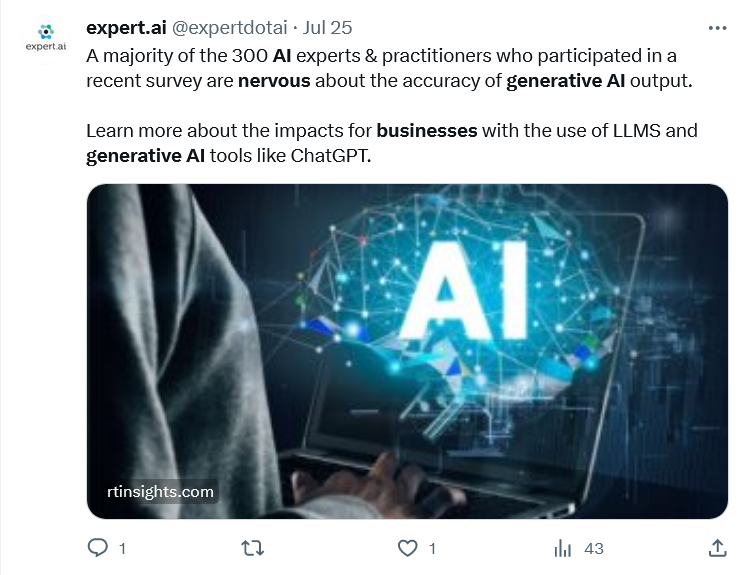
Business remain cautious over generative AI – potentially because they have a lot to lose if things go wrong.
APAC individuals understand generative AI – but brands hesitate
- Despite knowing what generative AI is, only 40% of APAC brands adopt it, highlighting a consumer-brand gap.
- Major brands globally harness generative AI’s power for advertising.
- Predictions claim there will be significant adoption over the next year.
Artificial intelligence’s transformative power extends beyond mere technological chatter. It has seamlessly integrated itself into the very essence of society. Both seasoned tech enthusiasts and the everyday person increasingly gravitate towards AI-driven innovations, fueling debates about AI’s more profound influence on our daily lives.
For the corporate world, this burgeoning AI era symbolizes a promising horizon. It serves as a linchpin that augments the creative capacities of marketing divisions, carving avenues for companies to establish their unique identities in a saturated marketplace, particularly when delving into generative AI.
APAC consumers are excited, but there’s a problem
Consumers and professionals in the Asia-Pacific (APAC) region exhibit a robust inclination towards generative AI. However, according to an Adobe-commissioned survey, while individual enthusiasm remains high, brands’ formal embrace of this technology has yet to keep pace.
The data suggests that of all global consumers, those in the APAC region are the most enthusiastic about the enhancements generative AI can bring to products and services. Their excitement is almost triple that of counterparts in areas like the US and Europe.
Yet, this enthusiasm hasn’t necessarily translated to rapid business adoption. Only 40% of brands in the Asia-Pacific have officially integrated generative AI, even though its utilization by individual professionals remains high.
Adobe’s managing director for Greater China, Tony Ng, commented on these findings, emphasizing the general agreement on generative AI’s potential to uplift employee productivity and customer experiences. Ng added a caveat, stressing the importance of companies establishing clear policies and oversight mechanisms when embracing generative AI to sidestep potential pitfalls.
Many surveyed APAC brands align with this sentiment, aiming to harness workflow and generative AI solutions to streamline business operations.
Global adventures in marketing with generative AI
Beyond the APAC region’s unique relationship with AI, major global brands are also exploring the potential of generative AI tools. Prominent brands are weaving AI into their marketing strategies to boost productivity and cost efficiency, indicating a broader global trend that transcends regional disparities.
As highlighted by Maginative, collaborative endeavors by renowned brands like Nestlé, Unilever, and Mondelez, partnered with advertising behemoth WPP, underscore the power of generative AI in optimizing marketing efforts. Their pioneering campaigns reveal the capability of AI to churn out brand-consistent content swiftly, radically slashing the time and resources typically required.
One remarkable instance is the AI-infused Cadbury campaign in India, orchestrated by WPP in tandem with Mondelez. Harnessing Bollywood megastar Shah Rukh Khan’s pre-existing footage and AI-scripted narratives, they unveiled over 130,000 bespoke social media advertisements, amassing 94 million views for a fraction of traditional ad costs.
Moreover, brands like Nestlé and Unilever have adeptly harmonized AI-crafted content with human refinement. Aude Gandon, Nestlé’s Global CMO, highlighted AI’s adeptness in spawning innovative campaign ideas that human experts subsequently refine.
However, as brands globally navigate the AI space, concerns around biased results, data protection, and intellectual property loom large. Brands are cautiously weighing the unmatched benefits against possible pitfalls.
Even as generative AI heralds an era of innovation, the emerging domain demands vigilance. Its vast implications are yet to unfold fully, but it is undeniable that human discernment and supervision remain paramount.
What is the risk in generative AI adoption?
The allure of generative AI, with its ability to spawn intelligent chat interfaces and craft text, images, or varied content, cannot be denied. However, industry specialists, particularly in marketing, have expressed apprehensions about data protection and intellectual property concerns.
As the South China Morning Post reported, a notable example is Hong Kong. Despite the global acclaim for chatbots like OpenAI’s ChatGPT, official endorsements in the region still need to be clarified. This lacuna fuels anxieties regarding Hong Kong’s stature as a global financial nexus.
Nevertheless, Hong Kong’s digital denizens have kept pace with evolving AI developments, primarily through alternative service providers. Quora’s chatbot consolidation tool, Poe, is illustrative, with a significant chunk of its worldwide user base hailing from Hong Kong.
Yet, companies need help in adopting renowned AI utilities, with intellectual property being a primary impediment. HSBC’s marketing campaign, which featured an AI-rendered image of a well-known Hong Kong comedian, exemplifies this. While acknowledging generative AI’s potential, the financial institution confronts dilemmas like the copyright status of AI-generated outputs. As such, HSBC is treading carefully, thoroughly assessing risks associated with platforms like ChatGPT before greenlighting broader implementation.
The ripple effects of accessible generative AI have permeated the artistic domain. Notably, several musicians have stumbled upon AI-crafted content that astonishingly mirrors their creations, raising pressing intellectual property questions. While various sectors view this tech evolution favorably, the creative community approaches it with measured optimism.
What is the upcoming trajectory for generative AI?
Adobe’s study underscores the consumer appeal of generative AI and highlights brand trust’s pivotal role in influencing consumer expenditures in a challenging fiscal climate. Paramount in forging customer allegiance is a company’s commitment to safeguarding data and aligning its usage with client expectations.

The benefits are undeniable – but what about the risks of generative AI?
But despite these challenges, the survey reveals a significant portion of global marketing and customer service professionals employ generative AI. Many have tapped into extensive language models, conversational AI, and other tools.
The study by Advanis, a market research entity, encompassed over 15,000 consumers and 4,000 marketing and customer service experts globally. Notably, China, known for its stringent generative AI regulations, was excluded from the survey.
Despite adoption barriers, Adobe predicts a steady rise in generative AI implementations by businesses. Projections indicate a 68% adoption rate in the upcoming months, surging to 87% within a year.
Forrester Research’s recent projections suggest an annual expenditure of US$79 billion on specialized tools to enhance automation and boost productivity across sectors like security, healthcare, and content marketing by 2023.
READ MORE
- 3 Steps to Successfully Automate Copilot for Microsoft 365 Implementation
- Trustworthy AI – the Promise of Enterprise-Friendly Generative Machine Learning with Dell and NVIDIA
- Strategies for Democratizing GenAI
- The criticality of endpoint management in cybersecurity and operations
- Ethical AI: The renewed importance of safeguarding data and customer privacy in Generative AI applications






